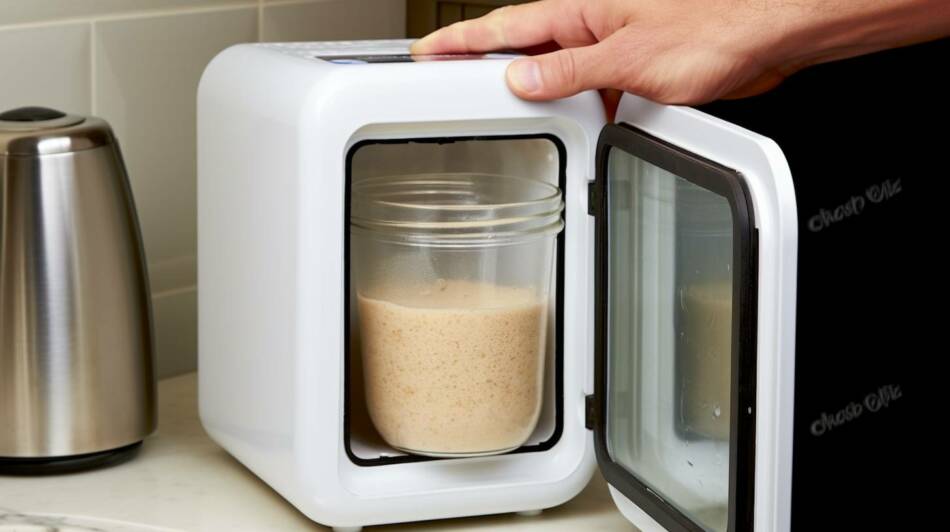For many sourdough enthusiasts, the question often arises: Can you use a sourdough starter directly from the fridge, or should you allow it to come to room temperature first? Let’s delve into the topic to bring clarity to this frequently pondered aspect of sourdough baking.
Using a sourdough starter straight from the fridge is possible. However, its cold state may yield a sharp sourish flavor and require longer fermentation times. For optimal results, many bakers prefer warming and feeding the starter before use to ensure predictable fermentation and consistent bread texture.
1. Understanding Refrigerated Starters
Many bakers, both novice and professional, opt to refrigerate their sourdough starters, particularly when they are not in the habit of baking on a daily basis. The core reason behind this is that the cool environment of a refrigerator slows down the fermentation process.
In practical terms, this means that the yeast and beneficial bacteria in the starter become less active, thereby requiring feeding less frequently. Instead of the daily feeding routine that room temperature starters demand, refrigerated ones can often get by with just a once-a-week refresher.
But there’s an interesting twist: refrigeration doesn’t kill the microbial activity. It merely makes it dormant. It’s like putting the microbes to sleep. When they’re in this state, they are not dead, but they’re not in their usual bustling state either. They’re in a kind of hibernation mode, waiting for warmer temperatures to wake up and get back to work.
2. The Case for Using it Straight from the Fridge
While some bakers religiously stick to bringing the starter back to room temperature and feeding it before use, others are fans of the straight-from-the-fridge method, especially when they’re in a hurry or are looking for specific results.
a. Flavor Dynamics
One of the most pronounced differences when using a refrigerated starter directly is in the flavor department. Such starters tend to produce a markedly more sour taste in your baked goods. This tanginess results from the accumulation of acetic acid over time in the cool environment of the fridge. For those who savor a more sourdough-y taste in their bread, this characteristic can be quite appealing.
b. Activity and Potency
At first glance, a starter straight from the cold might look a bit lackluster. Its bubbles might be fewer, and it might not have that lively frothiness of a starter that’s been happily fermenting at room temperature. But don’t let looks deceive you.
While its activity might seem muted, a refrigerated starter still possesses the power to make your bread rise. The catch? Its leavening prowess might be a tad less potent compared to a starter that’s been freshly fed and is raring to go.
When baking with a starter straight from the refrigerator, adjust with a longer fermentation time, at warmer temperature.
3. The Benefits of Bringing it to Room Temperature
a. Increased Vigor

When a cold sourdough starter is left out to warm, the dormant yeast and bacteria begin to awaken. By feeding it during this phase, you provide these microorganisms with fresh sustenance, allowing them to rebound with greater vigor. This revival of microbial activity translates to a more robust rise and more reliable fermentation when you start baking.
b. Flavor Development
The cool environment of the refrigerator leans the flavor of the starter towards the sour side, courtesy of accumulated acetic acid. However, when you feed your starter and let it ferment at room temperature, it offers a chance for the more mellow lactic acid to develop. This creates a harmonious balance between tangy and mild, ensuring your baked goods have a well-rounded taste.
c. Predictability
A critical aspect of baking, especially with sourdough, is predictability. When you work with a starter that’s been brought to room temperature and adequately fed, you’re dealing with a known entity. Its behavior, in terms of rising power and fermentation speed, will be more consistent, thus making the entire baking process smoother and the results repeatable.
4. How to Bake Using a Starter Straight from the Fridge
Choosing to use your sourdough starter directly from the refrigerator is a valid approach, especially for those in a hurry or aiming for a distinct taste. When doing so, be sure to follow these crucial steps:
a. Inspect
Before anything else, give your starter a good look and a sniff. What you want to avoid is any sign of mold or a particularly unpleasant odor, which can indicate spoilage. It’s worth noting that the presence of “hooch” – a somewhat alcoholic, clear greyish liquid that forms on the top – is natural and not a cause for concern. You can either pour it off or stir it back into the starter.
b. Stir
One of the challenges with cold sourdough starter is ensuring that the microbial distribution is uniform. This can be achieved by giving your starter a thorough stir. This action ensures that the yeast and bacteria are evenly spread out, allowing for even fermentation.
c. Increase Fermentation Times

Cold sourdough starter will inevitably mean that the fermentation dynamics are altered. More specifically, both fermentation and proofing stages will take longer than usual. Instead of adhering strictly to timeframes suggested in recipes, pay closer attention to the behavior and appearance of your dough. It will guide you more accurately than the ticking of a clock.
In Conclusion
Whether you choose to use your sourdough starter straight from the fridge or prefer bringing it to room temperature, both methods can yield delicious results. The key is to understand the nuances of each approach and adjust your expectations and processes accordingly. As with many aspects of sourdough baking, experience, observation, and personal preference will guide your journey to the perfect loaf.

